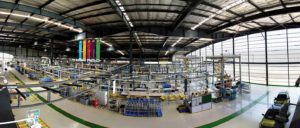Chetan Maini, chief of technology and strategy, Mahindra Reva, talks about how the 120-year-old DNA of the automobile industry is beginning to change and his plans for the company, going forward

Last month, in the heart of Electronic City in Bengaluru, I was getting ready to test drive the Mahindra Reva NXR, the electric passenger car that is slated to be launched shortly. As Pavan Sachdeva, general manager, marketing, Mahindra Reva and I got into the two-door, four-seater metallic green car, Sachdeva quickly instructed someone at the factory to unplug the car, as if it were a mobile phone. I am no expert in analysing cars, but to me it seemed like the NXR rode like a champ. Even as we touched 65 kmph, the sound made by the car or rather the absence of it, was exciting to note. We maneuvered the turns fairly well, braking comfortably as needed, and overall had a neat experience. And, here’s the best part: we didn’t spend a single rupee in fuel costs or emit any pollutants on this drive. The car was powered by Reva’s sun2car technology, where cars are charged using solar energy in parking garages with solar panel roofs.
To be sure, the concept of electric cars has been around for quiet sometime now. The challenge, really, lies in scaling up the market so that a sizable number of people turn to electric vehicles. From building widespread infrastructure for charging stations to modifying consumer behaviour, several aspects need to be looked at. In this cover story, we chat with Chetan Maini, founder of Reva Electric Car Company and now chief of strategy and technology at Mahindra Reva, to take us through what he believes is going to be the future of the automobile industry.
The strategy mix
Maini, of course, is the poster CEO of the Indian electric car world. He founded Reva in 1994 in Bengaluru with a passion to build electric vehicles. To put things in perspective, this was two years before Al Gore’s movie ‘An Inconvenient Truth’ had released and clean tech wasn’t a buzzword even in Silicon Valley venture capital circles. Over the next few years, Maini went on build tremendous expertise in electric vehicle (EV) technology.
“In 2009, at the Frankfurt Motor Show, I realised this was going to be a big play. That year, there were 42 electric cars that were showcased,” says Maini. At the time, he had two options – raise sizable private equity and compete with the big boys or partner with a strategic investor. “It really made sense to go with someone like the Mahindra Group. They had the manufacturing expertise, execution capabilities in vehicle distribution, financing, and a good brand. We could also leverage cost benefits in the sourcing process.” In May 2010, the US $15.4 billion Mahindra Group acquired Reva and Maini became the head of strategy and technology at Mahindra Reva.
“At the end of the day, the consumer is looking to reach his destination in half the time, in a safer manner, at half the cost, in a cleaner fashion.”
Today, Maini is focused on developing the roadmap for Reva and the electrification of platforms for other Mahindra products. He says, “One of my key responsibilities here is to get ready for the future. Three years from now, this business is going to be very different – battery technology will be different, platforms will be different.” That’s not all. As a pioneering company in this space, Mahindra Reva is gearing up to build up the overall ecosystem. Maini specifically mentions three technology offerings – sun2car, car2home and quick2charge. With sun2car, one can setup (at approx. Rs 1 lakh) a solar charging point for electric cars. These could be located at office parking lots or even at homes. Quick2charge is nothing but a gas station for electric cars. Cars can come in, get plugged into a charging point for 15 minutes and can run 25 km with this charge. NXR buyers will also get a plug point installed in their apartments or independent homes. It is part of the installation kit, like how dish antennas are added to enable satellite television. NXR owners can come home and connect to the plug point – which is connected to their meter – in their parking spot. Sun2car provisions electric car owners to connect their cars to their home electricity line and use excess energy as a power backup for one’s home.
Prior to the launch, the company is looking to deploy charging stations at over 150 outlets at various locations including malls, coffee shops and office parking lots. In Bengaluru, the company will be setting up charging stations at Gopalan mall, Forum mall and SAP Labs. “We are also in talks with organisations like IBM, Infosys and several other companies,” adds Maini.
From an ecosystem standpoint, Maini is convinced that there are several ideas that can be borrowed from a country like Norway, a location where there are more electric cars than traditional ones. Maini says, “The reason is simple. Any mall you go to, there are trickle charge plug points. The government planned incentive schemes for both electric car manufacturers and consumers. For example, if you owned an electric car, you could enter Oslo in a fast track lane. Each way, you could save about 20 to 30 minutes. It is these kinds of incentives that drove the adoption of electric cars in Norway.” Of course, India might be a different ball game altogether, but developing the ecosystem – of suppliers, charging points, manufacturers and dealers – to further develop the EV market is crucial.
Maini is convinced that the work over the next few years will bring in cost-effectiveness – a crucial component for mass adoption – into the equation. He adds: “While building products is the prime focus, we are also working on licensing our technology (powered by Mahindra Reva) and building a franchise manufacturing business unit. The next three years are really crucial, we have to prove what we believe is possible to achieve right now.”
As it is the case for any technology-driven enterprise, building intellectual property is at the core of Mahindra Reva. Maini says, “We even formed an IP committee to analyse all new technology related questions. The committee, which is lead by Lon Bell, a PhD. from Caltech University with over 75 patents, also includes Maini and some of the investors. Before every board meeting, they look at all technology related decisions that need to be made.”

The consumer puzzle
While technology is one part of the equation, it is gauging consumer behavior and coming up with products (with the right feature sets) that work, that is as crucial. Anand Mahindra, while inaugurating Mahindra Reva’s new factory in Bengaluru, succinctly explained that yet again he was going to resort to using alphabets to list out the company’s strategy. At the launch, he announced what he called “the future of mobility” and the 5Cs – clean, connected, clever, convenient and cost-effective – that would drive Automobile 2.0.
According to Maini, implementing the 5Cs will rely on a coordinated strategy between product marketing and research and development teams. Maini says, “I would say, today, EVs are part of the consideration set. Consumers are tired of the ever-increasing price of fuel. It is the convenience and value consciousness that will drive sales for EVs in India.” Overall, EVs are easier to maintain – there are no spark plugs or air filters and a basic car service can be done remotely by accessing a car online.
Maini believes that the early adopters of EVs will be tech savvy folks who drive to and fro work and don’t drive beyond 100 km a day. On prodding further on the importance of marketing and R&D working together on building feature sets, Maini talks about one of NXR’s features, REVive. “People walking into a dealership ask this question – what do we do if we suddenly run out of charge? Our answer to this question is REVive. With this feature, technology has been created to enable the car to run a little more when it is out of charge. If your car runs out of charge, you send us an SMS. Just by connecting to the car online, we will be able to revive the car with enough charge to get home. In reality, it is the anxiety of the customer we are tackling here.”
If you haven’t noticed this already, Maini talks about cars as if they are devices connected on the Internet. Well, they really are. One of the 5Cs that Mahindra pointed out in his talk is about connected cars. He means cars are connected to a driver and in some cases, cars are even connected to each other, say, maybe to prevent accidents. Now, these are features that are useful and at the same time, fascinating. The term Automobile 2.0, really, refers to all this. On one side, it is about zero-emission cars that run without dependence on oil. On the other hand, it is about adding the element of fascination for its customers with cars that are online and can be revived through a mobile phone app!
Recently, Google experimented with a robotic car, one that drives without a driver. In some cities, we are seeing the fundamental model of car ownership changing. Rather than owning cars, people are moving to mobility-as-a-service, where depending on the need of the day or month, they pay to use a particular car. As mentioned before, in Norway, there are more electric cars than traditional ones. Maini says, “At the end of the day, the consumer is looking to reach his destination in half the time, in a safer manner, at half the cost, in a cleaner fashion.” This he believes will be the future. Alan Kay, the American computer scientist once said, “The best way to predict the future is to invent it.” I guess, when Maini and Mahindra used the term ‘future of mobility’, they certainly knew what they were talking about.
CHETAN MAINI’S TOP 5 PRIORITIES
Product roadmap and technology development strategy for both Reva and electrification of the Mahindra platforms
Launch NXR and also launch three key products over the next three years
Get ready for the future. The next generation technology platforms will be very different
Get the ecosystem ready – charging stations, supplier network, new technology for charging
Establish the two other business units – mobility solutions and franchise manufacturing. In the mobility solutions business, technology will be licensed to other brands and a battery financing business will be launched
- Manufactured in an ultra-low carbon assembly plant in Bengaluru. The factory, the only one of its kind in India, has been given a platinum rating by the Indian Green Building Council.
- 35 per cent of the energy consumption for industrial use comes from a solar farm in the facility. Cars get their first charge from solar.
- 100 per cent of the factory is lit by LEDs and skylights reduce electricity consumption. Pre-painted sheets are used avoiding pollution from painting processes within the factory. A translucent honeycomb mesh and insulated high roof ensure temperature maintenance.
- As owners return home, excess charge stored in the car can be used to power your home, almost like a generator
- Reva is working on tie-ups with various companies to deploy solar-powered parking lots in their office premises. Car owners charge their cars while they are at work free of cost
- Your home parking garage will have charging stations – which are connected to the electricity meter – installed. The charging kit is part of the package when you buy a Reva.
